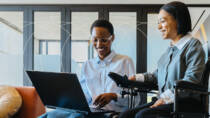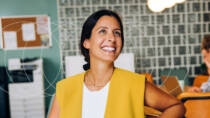2026: The 10 BIG conversations happening in workplaces
By Sally Pritchett
CEO
These conversations are already happening in your workforce. Are you part of them?
Whether you’re leading or part of these conversations or not, your workforce is having them. The challenge is that when organisations stay silent, employees fill the gaps – and increasingly, they’re doing that loudly and publicly.
If you want to know what your workforce is talking about, you need to lean in.
1. The transaction of work
Over the last few years, the topic of balancing productivity with pay has surfaced in different ways. Remember Quiet Quitting? This conversation will not only continue to rumble into 2026 – it’s likely to get louder and bolder. But not all communication uses words. Actions and behaviours communicate just as clearly.
This is about the increasingly blurry lines of the work transaction – what an employer “gets” from an employee in return for the pay they offer. In theory, this should be simple. Employment contracts, policies and working hours exist to make it clear. In reality, it’s becoming harder to pin down.
Pre-pandemic, in most organisations, being on the premises implied you were working (rest breaks aside). Leaders could see who was “working harder” – the first-in, last-out brigade. Presenteeism aside, hybrid working has blurred those lines. Some leaders felt productivity took a hit with working from home and mandated a return to the office to re-establish clearer boundaries. Others recognised they were “up on the deal” – removing long commutes and enabling flexibility led to more discretionary effort, not less.
Raised in an uncertain world of permanent crisis, Gen Z are strong boundary protectors. Look at social media conversations around #ActYourWage and #BareMinimumMonday and you’ll see their clarity on the work transaction. Over-delivering today for the promise of career progression tomorrow isn’t their priority. Being paid fairly for the work they do is.
Organisations may feel backed into a corner, with limited scope for pay increases or bonuses. But this conversation isn’t going away. In fact, if organisations don’t lead it, they will lose control of it.
This is no longer just about productivity or pay. It’s about clearly defining the modern work transaction: what’s expected, what’s optional, where flexibility ends and additional responsibility begins, and when “going the extra mile” quietly becomes a role change that should be recognised and paid for. At its heart, this is culture.
Managers sit at the sharp end of this, yet they’re often left to interpret the rules themselves. That creates inconsistency, resentment and risk. Coaching managers on what’s acceptable, what’s sustainable and how to have honest conversations about boundaries and workload isn’t a nice-to-have – it’s critical to maintaining a healthy, happy workforce.
The killer takeaway: If you don’t define the deal, your workforce will.
2. Workforce whiplash
The second conversation likely to dominate workplaces is change. Change itself isn’t new, it’s always been part of working life. The arrival of computers in the late 1970s wasn’t just about new technology; it dismantled entire typing pools, reshaped administrative work and fundamentally shifted workplace communication. It took years to retrain people, redefine roles and rebalance expectations.
Today, we’re facing a similar scale of disruption – and we won’t win overnight. Yet the race is on. Many organisations feel intense pressure to adopt and embed AI faster than competitors simply to survive. That urgency is leading to billions being poured into technology projects before they’re ready. Success or failure still hinges largely on the people leading, driving and delivering them.
“Gartner has warned that a large share of AI projects will be scrapped post proof-of-concept, estimating that around 40% of agentic AI initiatives could be cancelled before delivering results. Meanwhile, an MIT study found that up to 95% of generative AI pilots are failing to deliver measurable business value. Forbes reports that despite $30–$40bn invested in generative AI in 2025, most corporate AI efforts aren’t moving the needle.”
While change isn’t new, its volume, complexity and speed are – and that’s what the workforce is reacting to. Exhausted by relentless initiatives and transformation programmes, change fatigue has set in. What leaders sometimes label as resistance is often saturation.
From pandemics to cyber-attacks to the rapid arrival of AI, disruptions feel constant and unpredictable. There’s little time to recover before the next shock hits, creating real whiplash.
The answer isn’t to try to slow change, but to acknowledge its human impact. Organisations can mandate change, but they can’t mandate adoption or commitment. Making change stick requires clear, consistent narratives and compelling stories that build trust and rhythm.
The killer takeaway: Change moves at human speed.
3. The commercial imperative of DEI
Another conversation quietly gathering momentum into 2026 is the quiet return of DEI. After years of growing traction, progress stalled for many organisations in 2025. High-profile roll-back rhetoric – from Trump’s calls to dismantle DEI to Musk’s “DEI must DIE” comments – created confusion about its role.
But as headlines moved on, a more grounded recognition emerged. What needed to be rolled back wasn’t inclusion itself, but performative tokenism. Bias, exclusion and discrimination are bad for business – damaging culture and constraining growth.
The beauty industry faced backlash for foundation ranges that failed to reflect real skin tones. Tech platforms like LinkedIn were challenged for amplifying male voices over female ones, driving some creators towards competitors like Substack. Meanwhile, organisations such as the Diversity Standards Collective have helped major consumer brands ensure advertising lands authentically – after missteps from brands like Heinz, Nivea and Dove showed the cost of getting it wrong.
What was always true is becoming more explicit: inclusive cultures think and innovate more broadly. That leads to better products, stronger brands, improved customer experiences and more sustainable growth.
As we head into 2026, acronyms matter less. What does matter is intent, consistent investment and meaningful action.
The killer takeaway: Inclusion is an often untapped growth strategy.
4. The cost of futility
At a time of constant disruption, one of the quietest workplace crises isn’t about pay or AI – it’s futility.
When work feels endless, transactional and disconnected, it drains energy, motivation and engagement. This came through clearly in engagement data throughout the year.
One statistic in particular should give organisations pause: just 18% of workers say their role aligns with a purpose they personally believe in. That’s the cost of futility. By contrast, employees who believe their work contributes to something meaningful are 5.6 times more likely to be engaged (Gallup).
When people feel they’re working harder simply to grow company profit, motivation suffers. But when they can connect daily work to genuine impact they believe in, pride and commitment grow.
Organisations need to invest more effort in bringing purpose to life – connecting the big picture to everyday tasks and telling better stories about the impact they’re making. Purpose isn’t reserved for businesses like B Corps. Every organisation needs to be clear why it exists and the difference it makes.
The killer takeaway: Just like pay, purpose is a critical motivator.
5. Closing the culture atrophy
Culture hasn’t disappeared over the last few years, but in many organisations it has quietly atrophied – it has wasted away, losing its vigour.
Gartner used this exact term when urging CHROs to prioritise closing culture gaps. Whether deliberate or not, many organisations shifted focus from people to technology. Yet success with technology still depends on human leadership, judgement and adoption. Running a human workforce with a machine mindset has real limitations.
What worked for creating lean manufacturing processes doesn’t translate to today’s skills landscape, where innovation, creativity and independent thinking are critical.
Progress-driven cultures must feel safe – allowing people to speak up, experiment and fail without fear of career-limiting consequences. Workforces are human systems, and cultures need to reflect that.
Closing the gap starts with being honest about culture reality – how they shape up against the theory of culture written in employee handbooks and EVPs. That requires genuinely listening to employees, and sometimes bringing in external perspective, before doubling down on change.
The killer takeaway: When everyone has access to technology, humans are the advantage.
6. Multi-generational: power and conflict
No, it’s not a bestselling novel, though it could be. This conversation centres on five generations working side by side.
From Gen Z entering the workforce to Baby Boomers staying on longer, today’s organisations carry an unprecedented mix of expectations, communication styles and values. In theory, a strength. In practice, often a source of friction.
Different generations hold different assumptions about commitment, professionalism, boundaries, pace and authority. Layered on top are unhelpful stereotypes that deepen divides.
Left unchecked, this creates misunderstanding, friction and miscommunication. On the other hand, when we lead proactive and positive conversations, it becomes a powerful source of learning. Experience and deep expertise meets fresh perspectives, improving decision-making, digital fluency and workplace dynamics.
The killer takeaway: Generational diversity is a powerful engine for growth.
7. From feedback to dialogue
Employee voice isn’t a new idea, but expectations around it have changed. For years, organisations relied on annual surveys, pulse checks and suggestion schemes. Implicitly, the message was: you can speak up, but we’ll listen and act on our terms.
That approach no longer works. Employees expect to feel safe speaking up consistently, and to be heard by leaders in real time. This is driven both by younger generations and by wider societal expectations around transparency and the chance to influence in others parts of our lives.
Recent survey results have been uncomfortable for many organisations: declining trust in leadership, demands for clearer direction and expectations for stronger stances on big topics like climate, wellbeing and social issues. This isn’t the same feedback as a few years ago.
Leaders now need to invest not just in listening, but in responding – acting where possible and openly acknowledging where they can’t. But most importantly, having honest conversations.
The killer takeaway: Listening to employees is a trust-building strategy.
8. Reimagining flexibility
The return-to-office debate has become exhausting for everyone. As we look ahead, it’s time to accept that the new norm is more flexible than pre-pandemic, with working patterns designed around human needs.
Organisations that want to make flexibility work must lead the conversation – creating a cadence that supports motivation and productivity while ensuring inclusion and fairness.
From an employee perspective, the direction is clear. Groups such as Pregnant Then Screwed, Flex Appeal and Workstyle are gaining momentum in pushing for stronger flexible working rights because it’s what employees are demanding.
The opportunity here lies in collaboration. From creating shift-swap options to altering shift timings and empowering manager-led flexibility within clear guardrails, this goes beyond policies and into trust-building. The critical success factor is dialogue – co-creating solutions rather than imposing them in isolation.
The killer takeaway: Flexibility rewards organisations that dial down control and dial up trust.
9. Reframing performance
Wellbeing has often been treated as a standalone conversation – awareness days, workshops and specific issues like stress or menopause. All are important. But the bigger question is often avoided: how does the organisation enable people to perform at their best? In the year ahead, organisations need to look beyond webinars and workshops and instead at how they are genuinely improving workplace performance.
High performance and wellbeing aren’t in tension, they’re connected. People do their best work when they have energy, clarity and psychological safety. When they feel trusted, not monitored. Enabled, not undermined. Stretched, not overloaded. Valued, not forgotten.
Wellbeing is a culture conversation with a performance outcome. Organisations need to rethink how they’re talking about wellbeing – recognising their responsibility to create environments where people can deliver their best work, while employees focus on bringing their best selves to work.
The killer takeaway: Wellbeing isn’t a benefit. It’s a performance driver.
10. The emotional elephant in the room
Leadership is being reshaped, and it’s time to talk seriously about human leadership.
We’ve heard the language: leaders need to be more empathetic, authentic, vulnerable. But the reality is harder. Since the pandemic, uncertainty has become the default. Topics like AI and climate are too complex for any leader to have all the answers.
Every initiative and transformation hides an emotional iceberg that leaders can’t ignore – fear, anxiety, fatigue, cynicism and frustration. These emotions don’t stay outside work. They come to work with employees.
The real conversation is how we give leaders permission to handle this complexity without pretending they have all the answers.
The killer takeaway: Human leadership is about guidance, not answers.
You don’t choose the conversations – but you can choose to lead them
The question for organisations isn’t which of these conversations to have. They’re all happening, everywhere.
The real question is this: which ones are you brave enough to lead?
If you want to start having these conversations or lead them with confidence rather than react to them, we’re here to support you.
Because these conversations are happening anyway. The only choice is whether you’re part of them.
Green Monday 2026: What’s On
By Sally Pritchett
CEO
Discover this year’s Green Monday sessions and resources for thoughtful sustainability conversations.
The third Monday in January is widely known as Blue Monday, often labelled the most depressing day of the year. Three years ago, we decided to flip that narrative. Green Monday is our antidote – a day we dedicate to sustainability, connection and practical action. Each year, we bring people together for conversations and experiences that spark new ideas and drive progress.
For 2026, we are hosting two sessions focused on the communication challenges that shape sustainability work, plus a new resource to help you run your own Green Monday NetWalk.
NetWalk
Time: 8am-10am GMT, Mon 19 Jan 2026
Tannery Studios, Tannery Lane Send, Woking Surrey, GU23 7EF
Start Green Monday with a morning NetWalk through the Surrey countryside. It is a great opportunity to meet others who care about making a positive impact on our planet and to share ideas in an informal setting. Led by our CEO, Sally Pritchett, and Ali Fisher from Plans With Purpose, we will meet at the Something Big office for a warm drink before heading out together.
Rain or shine, boots or wellies are a must!
Closing the Gap – Turning Sustainability Strategy into Everyday Employee Action
Time: 12pm-1pm GMT, Mon 19 Jan 2026
Online, Teams
Sustainability strategies often look clear on paper, yet feel anything but clear in the day to day. Teams are already overloaded with information, priorities and internal messaging which makes it harder for people to know what to do, when to do it and how it fits into their role. So even when employees care, there is still a gap between intention and action.
In this one hour session, we will explore what gets lost in the noise and what it takes to make sustainability feel practical and relatable for busy teams.
New for 2026: Run Your Own Green Monday NetWalk
Free downloadable guide
If you’d like to bring Green Monday into your organisation, team or community, we’ve created a simple one page guide to help you run your own NetWalk.
It includes:
- Tips for planning
- Conversation starters
- Ready to use social media assets to help you celebrate your walk
Download the guide now and get everything you need to run a Green Monday NetWalk wherever you are.
Powered by Work Wonders

10 Years of UK B Corps: Proud of the past, fired up for the future
By Sally Pritchett
CEO
Celebrating 10 years of the UK B Corp movement – and three years of Something Big being part of it
This year marks a major milestone: the UK B Corp movement turns 10. It’s a chance to reflect on how far the community has come and the impact we’re all still building.
We’ve been a certified B Corp for just over three of those ten years. And while the values that earned us that certification were already in place, B Corp gave us something bigger – a clear, credible way to turn all our good intentions into real action, and access to a growing network of people doing the same.
As we look back with pride – and forward with purpose – here are 10 things we value most about being part of this movement:
1. A clear framework for doing good business
B Corp is more to us than a badge, it gives us structure. The framework gives us a way to hold ourselves accountable, and to turn our desire to do good into real purpose and action.
2. A community with shared values
We’re part of a global network that believe business should be a force for good. And we don’t just sit in the network – we really show up. From forming alliances with other B Corps to co-leading B Local Surrey, we’re proud to be actively involved.
3. A continuous improvement mindset
B Corp is not just a one-time award. The assessment challenges us to keep raising the bar – on how we treat people, the planet, and our stakeholders. We’ve already got stuck into the new standards, and we’re excited to keep moving forward.
4. Attracting and keeping great people
B Corp helps us attract people who care about purpose and impact. It tells our team – and future team members – that this is a place where you can do work that really matters, with values you can believe in.
5. Stronger client and partner relationships
More and more clients are looking for suppliers who align with their values. B Corp makes that alignment visible – helping us build trust faster and form more meaningful, values-led partnerships.
6. Greater transparency and trust
Our impact has always mattered to us – but now it’s visible to others too. Our current score of 128.2 places us among the highest-performing B Corps globally. And while the new standards in the future won’t provide a score in the same way, they do raise the bar even further – something we fully support.
7. A voice for change
Being part of the movement means contributing to something bigger. B Corps are influencing how businesses think, how supply chains operate and how decisions are made. There’s strength in working together.
8. Better decisions, long-term thinking
The framework asks us to consider more than just shareholders. It reminds us to think about people, communities, customers and the environment – helping us make more balanced, sustainable choices.
9. Energy and inspiration from others
The B Corp community is full of ideas, support and encouragement. From local meet-ups to national events, we’ve found the connections and conversations energising and full of practical ways to grow.
10. Proof that profit and purpose can thrive together
B Corps are proving, every day, that success and impact aren’t mutually exclusive. You don’t have to choose between running a strong business and doing the right thing – in fact, one strengthens the other.
Looking ahead
Three years into our B Corp journey, we’re more committed than ever. And as the UK movement celebrates its 10th year, we’re proud to be part of something that’s redefining what business can be. Here’s to the next 10!
People and culture business cases toolkit
By Sally Pritchett
CEO
Download your toolkit to build a business case for people and culture initiatives.
Need to make the case for investing in culture, wellbeing or communication? You’re not alone. Many great ideas struggle to get funded because their impact isn’t always easy to measure.
This two-part toolkit helps you change that. It’s built around our THRIVE methodology – a framework that helps organisations strengthen culture through communication. Each section looks at one of the six pillars that shape how people feel and perform at work: Talent, Human, Roadmap, Inclusion, Values and Experience.
Practical tools to help you make a business case for people and culture
In the free download, you’ll get:
-
Quick facts and data to show why culture, wellbeing and inclusion matter to business performance
-
Prompts and insights to help you link people-focused programmes to strategic outcomes
-
A link to an editable template to shape your ideas into a strong, evidence-based business case
It’s a practical way to back your ideas with evidence, show measurable impact and win support for people-focused change.
Want to dig deeper? Catch up on our webinar, including the 6 best hacks for successfully winning investment – full of practical advice to help you strengthen your next pitch.
If you’d like to build on it with deeper insight or strategic support, our Co-Creator advisory services are here to help you plan smarter and move your culture forward. And if you need support forming your business case for people and culture initiatives, talk to us – we’re always happy to help you think it through.
Download now and start building your business case
Workplace Safety Calendar 2026
By Sally Pritchett
CEO
Free downloadable calendar of key workplace health and safety awareness days.
Keep safety front of mind all year round
Our free Workplace Safety Calendar highlights the key dates that help you plan safety communications and keep teams focused on what matters most – staying safe.
From construction sites to warehouses and offices, consistent communication helps make safety part of everyday thinking. Awareness days are a simple but powerful way to bring key messages to life, cut through the noise and build understanding across large, dispersed or frontline teams.
What’s inside
- Key UK and global workplace safety and health awareness days
- Dates covering topics from fire safety to mental health and safe driving
- Practical ideas to help you share clear, consistent safety messages all year
If you find this calendar helpful, you might also like: Employee Wellbeing Calendar 2026, Sustainability and Environmental Awareness Calendar 2026, Future of Work, Productivity & Digital Skills Calendar 2026, and Diversity and Inclusion Calendar 2026.
If you’re running safety programmes or looking to strengthen how safety is communicated across your workforce, get in touch to see how we can help.
Download your free Workplace Safety Calendar 2026
Sustainability and Environmental Awareness Calendar 2026
By Sally Pritchett
CEO
Free downloadable calendar of key sustainability and environmental awareness days.
Keep sustainability on the agenda all year round
Our free Sustainability and Environmental Awareness Calendar brings together key global dates and events to help you plan meaningful activity throughout 2026.
With sustainability now central to how people choose where to work and what brands to trust, keeping the conversation alive matters. 68% of jobseekers say an organisation’s environmental policies influence where they apply, and 65% say it affects whether they stay. This calendar helps you connect your sustainability goals with communication moments that inspire action and pride.
What’s inside
-
Global and UK sustainability and environmental awareness days
-
Dates covering climate action, conservation, recycling, and sustainable living
-
Practical ideas to turn awareness days into engaging campaigns and conversations
If you find this calendar helpful, you might also like: Diversity and Inclusion Calendar 2026, Employee Wellbeing Calendar 2026, Future of Work, Productivity & Digital Skills Calendar 2026, and Health and Safety Awareness Calendar 2026.
If you’re looking to strengthen your sustainability communications or bring your ESG story to life for employees, get in touch to see how we can help.
Download your free Sustainability and Environmental Awareness Calendar 2026
Future of Work, Productivity & Digital Skills Calendar 2026
By Sally Pritchett
CEO
Free downloadable calendar of key dates focused on the future of work, productivity and digital skills.
Help your people thrive in the future of work
Our free Future of Work, Productivity and Digital Skills Calendar brings together key global dates that spotlight innovation, learning and technology in the workplace.
As AI, automation and digitisation continue to reshape how we work, communication is key to keeping your people informed, confident and engaged. This calendar helps you do just that – giving you moments throughout the year to spark conversations, share progress and build digital confidence across your organisation.
Research shows that 52% of employees are worried about how AI might be used in the workplace, while only 36% feel hopeful. Using these key dates as prompts for dialogue helps shift that balance — turning uncertainty into opportunity and helping people feel part of the journey.
What’s inside
- Key global dates focused on technology, digital learning and productivity
- Awareness days celebrating innovation, AI and the evolving world of work
- Practical ideas to help you communicate change and bring people with you
If you find this calendar helpful, you might also like our Diversity and Inclusion Calendar 2026 and Employee Wellbeing Calendar 2026.
If you’re driving digital transformation or looking for communication support to help your people adapt with confidence, get in touch to see how we can help.
Download your free Future of Work, Productivity & Digital Skills Calendar 2026
Employee Wellbeing Calendar 2026
By Sally Pritchett
CEO
Free downloadable calendar of key UK employee wellbeing awareness days.
Support employee wellbeing in 2026
Our free UK Employee Wellbeing Calendar highlights the key awareness days that help you plan meaningful wellbeing activities across the year.
With 78% of employees saying work stress affects their wellbeing, creating supportive and positive workplaces has never been more important. The good news is that 89% of employees say their leaders are now more open about discussing mental health – showing real progress in how organisations care for their people.
What’s inside
-
A wide range of UK and global wellbeing awareness days
-
Dates focused on mental, emotional, physical and financial wellbeing
-
Practical ideas to help you turn awareness days into meaningful action and conversation
If you find this calendar helpful, you might also like: Diversity and Inclusion Calendar 2026, Sustainability and Environmental Awareness Calendar 2026, Future of Work, Productivity & Digital Skills Calendar 2026, and Workplace Safety Awareness Calendar 2026.
If you’re developing your wellbeing strategy or looking to engage employees in a more meaningful way, get in touch to see how we can help.
Download your free Employee Wellbeing Calendar 2026
Diversity and Inclusion Calendar 2026
By Sally Pritchett
CEO
Free downloadable calendar of key UK diversity and inclusion awareness days
Make it easier to plan meaningful inclusion activity throughout 2026
Our free UK Diversity and Inclusion Calendar brings together the key awareness days, cultural celebrations and events that matter most to your people.
Creating a workplace where everyone feels they belong takes ongoing effort. With 65% of employees wanting to feel a stronger sense of belonging at work, staying aware of important diversity and inclusion dates can help you keep that focus alive across the year.
What’s inside
-
A wide range of UK and global diversity and inclusion awareness days
-
Dates covering cultural, religious, age, gender, disability and LGBTQ+ awareness and inclusion
-
Practical ideas for how to turn awareness days into meaningful conversations and actions
If you find this calendar helpful, you might also like: Employee Wellbeing Calendar 2026, Sustainability and Environmental Awareness Calendar 2026, Future of Work, Productivity & Digital Skills Calendar 2026, and Workplace Safety Awareness Calendar 2026.
If you’re developing your inclusion strategy or looking to engage employees in a more meaningful way, get in touch to see how we can help.
Download your free Diversity and Inclusion Calendar 2026
Guide: How to Successfully Communicate Change
By Sally Pritchett
CEO
Your shortcut to change communications that build trust and make progress stick.
Change is hard. Around 70% of organisational change efforts fail – and poor communication is often one of the biggest cause. Employees are feeling overwhelmed, leaders are struggling to bring everyone on board, and transformation plans are stalling before they even get going.
If you’re looking for practical advice on how to communicate change effectively, this manual is for you.
Why change communications matter
Whether you’re navigating a restructure, embedding new technology, or rolling out a refreshed strategy, communication can make or break your change initiative. Successful change communication:
-
builds clarity and alignment
-
reassures and motivates people
-
keeps culture strong in times of uncertainty
-
drives real, lasting behaviour change
Inside the Big Change Communications Manual
Our free guide shares practical tools and proven techniques to help you lead change with confidence. You’ll discover how to:
-
Create the right environment for change by listening and setting clear goals
-
Use the right language and tone to build trust and reduce anxiety
-
Make complex change clear through storytelling and relatable examples
-
Keep change alive with a steady rhythm of updates and celebrations
-
Protect and evolve your culture so it carries people through uncertainty
Who is it for?
This manual is designed for leaders, HR teams and internal communications professionals who want to engage employees and make change stick. Whether you’re preparing for a major transformation or simply want to strengthen your day-to-day change communications, the insights will help.
Ready to make your next change a success? Download the Big Change Communications Manual and start building belief in your strategy.
Download here: How to successfully communicate change
We’ve created two accessible versions of the manual – light and dark mode – both optimised for screen readers. Choose the one that works best for you. Need help? Get in touch hello@somethingbig.co.uk.
PDF version
A PDF that can be read by a screen reader
Dark mode PDF
A PDF in dark mode, that can be read by a screen reader














